
The Sydney Football Stadium, commercially known as Allianz Stadium and previously Aussie Stadium, was a football stadium in the Moore Park suburb of Sydney, New South Wales, Australia. Built in 1988 next to the Sydney Cricket Ground, the stadium was Sydney's premier rectangular field venue for rugby league, rugby union and football.

The Australia men's national rugby union team, nicknamed the Wallabies, is the representative men's national team in the sport of rugby union for the nation of Australia. The team first played at Sydney in 1899, winning their first test match against the touring British Isles team.
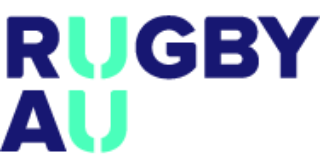
Rugby Australia Ltd, previously named Australian Rugby Union Limited and Australian Rugby Football Union Limited, is an Australian company operating the premier rugby union competition in Australia and teams. It has its origins in 1949. It is a member of World Rugby. Rugby Australia has eight member unions, representing each state and the Northern Territory and Australian Capital Territory. It also manages national representative rugby union teams, including the Wallabies and the Wallaroos.

The South Sydney District Rugby League Football Club, also known as the South Sydney Rabbitohs, is an Australian professional rugby league football club based in the Sydney suburb of Maroubra that competes in the National Rugby League (NRL). They are often nicknamed Souths or theBunnies.

Parramatta Stadium was a sports stadium in Parramatta, New South Wales, Australia, 24 km (15 mi) west of Sydney CBD. The stadium was the home ground of several western Sydney-based sports teams, at the time of closure the most notable were the Parramatta Eels of the National Rugby League and the Western Sydney Wanderers of the A-League.

Rugby union in Australia has a history of organised competition dating back to the late 1860s. Although traditionally most popular in Australia's rugby football strongholds of New South Wales, Queensland and the ACT, it is played throughout the nation.
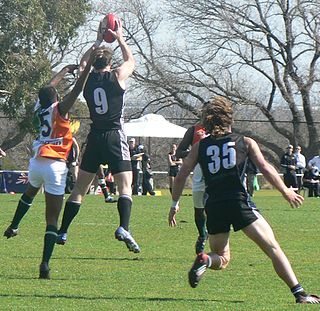
In New Zealand, Australian rules football dates back to the 1860s, was home to the first club formed outside Australia in 1876 and was the first colony outside of Australia to take up the sport. The sport's official name was changed in 1890 to Australasian Football acknowledge New Zealand's participation and remained for some time even after the country was expelled from the Australasian Football Council. After a half century hiatus of organised competition, it has grown rapidly as an amateur sport. Today five of New Zealand's sixteen regions have organised competitions: Auckland ; Canterbury ; Wellington ; Waikato and Otago. A four-team national competition with a national draft has been contested at the North Harbour Stadium in Auckland since 2016 for men and 2019 for women. The national team were crowned International champions at the 2005 Australian Football International Cup and competed annually against the AFL Academy between 2012 and 2019. Between the 2010s until 2022 the game was played in New Zealand schools.

Frank Burge was one of the greatest forwards in the history of rugby league in Australia. Later Burge became one of the game's finest coaches. His club career was with Glebe and the St. George Dragons. He represented New South Wales on twenty-six occasions and played thirteen test matches for the Kangaroos and played for Australia in a further twenty-three tour matches.
John Brass is an Australian former rugby union and rugby league footballer – a dual-code international. He made twelve international representative rugby union appearances with the Wallabies from 1966 to 1968 and six representative rugby league appearances for the Kangaroos in 1970 and 1975, as national captain on one occasion.
The 1909 New South Wales Rugby Football League premiership was the second season of Sydney's top-level rugby league football competition, Australia's first. Eight teams contested during the season for the premiership and the Royal Agricultural Society Challenge Shield; seven teams from Sydney and one team from Newcastle, New South Wales.

The Australia women's national rugby union team, also known as the Wallaroos, has competed at all Women's Rugby World Cups since 1998, with their best result finishing in third place in 2010.
Ronald James Lisle was an Australian rugby union and rugby league player and a dual code rugby international. He represented the Wallabies in 4 tests in 1961 and the Australia national rugby league team in 13 matches on the 1963 Kangaroo tour.
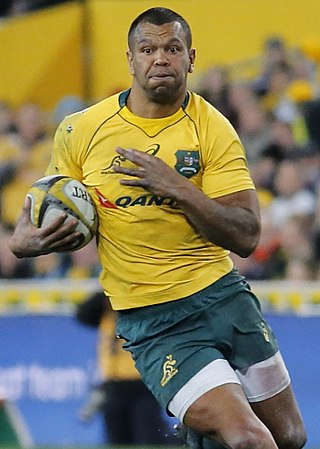
Kurtley James Beale is an Australian professional rugby union representative player who has made over 90 national representative appearances in a ten-year playing career at the world-class level. He is of Aboriginal descent, has had a long Super Rugby career with the New South Wales Waratahs and has played for the Melbourne Rebels and the Wasps club in England. Beale usually plays at full-back or centre but can play fly-half or winger. In 2011 Beale received the John Eales Medal, awarded to Australian rugby's Player of the Year.
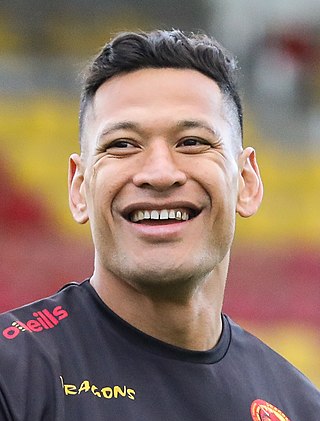
Israel ‘Isileli Folau is a professional dual-code rugby player who plays as a fullback for Japan Rugby League One club Urayasu D-Rocks. Born in Australia, he represents Tonga at international level after qualifying on ancestry grounds.
Matt Hodgson is an Australian sports administrator and former professional rugby union player for the Western Force and the Wallabies, the Australian national team. He is currently head of rugby at Global Rapid Rugby which launched its Asia-Pacific Showcase competition in 2019.

Tyson Lomano David Frizell is a professional rugby league footballer who usually plays as a second-rower for the Newcastle Knights in the NRL. Frizell has the distinction of appearing for three different national teams. He represented Wales in the 2011 Four Nations and 2013 World Cup, then Australia between 2016 and 2019, including the 2017 World Cup, and most recently Tonga.
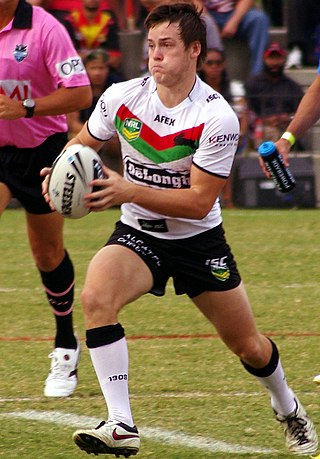
Luke Keary is a professional rugby league footballer who plays as a five-eighth or halfback for the Catalans Dragons in the Super League and Ireland at international level.
The Newcastle rugby league team is a representative rugby league football team made up of players selected from the Newcastle Rugby League's first grade clubs. Also called Newcastle Firsts, the team has been assembled occasionally since rugby league's first season in Australia in 1908.

The National Rugby Championship, known as NRC, was an Australian rugby union competition. It was contested by eight teams, seven from Australia and one from Fiji. The tournament ran from 2014 until 2019 before being disbanded in 2020 following the change of the Australian rugby TV broadcasting deal from Fox Sports, who had funded the competition, to Stan Sport. The 2020 competition was cancelled due to the COVID-19 pandemic.

Joshua Addo-Carr, nicknamed "The Foxx", is an Indigenous Australian professional rugby league footballer who plays as a winger for the Parramatta Eels in the National Rugby League and Australia at international level. Addo-Carr is a dual premiership winner 2017 and 2020 with the Melbourne Storm and 2021 World Cup winner.














